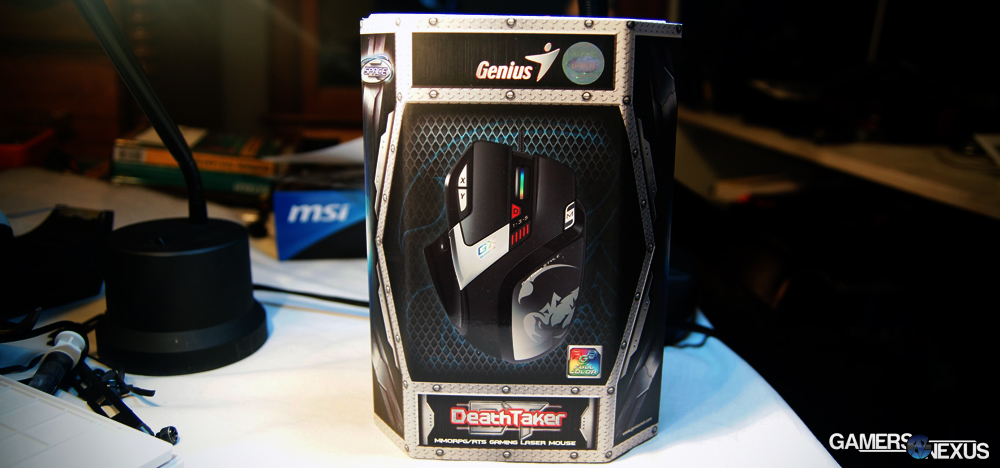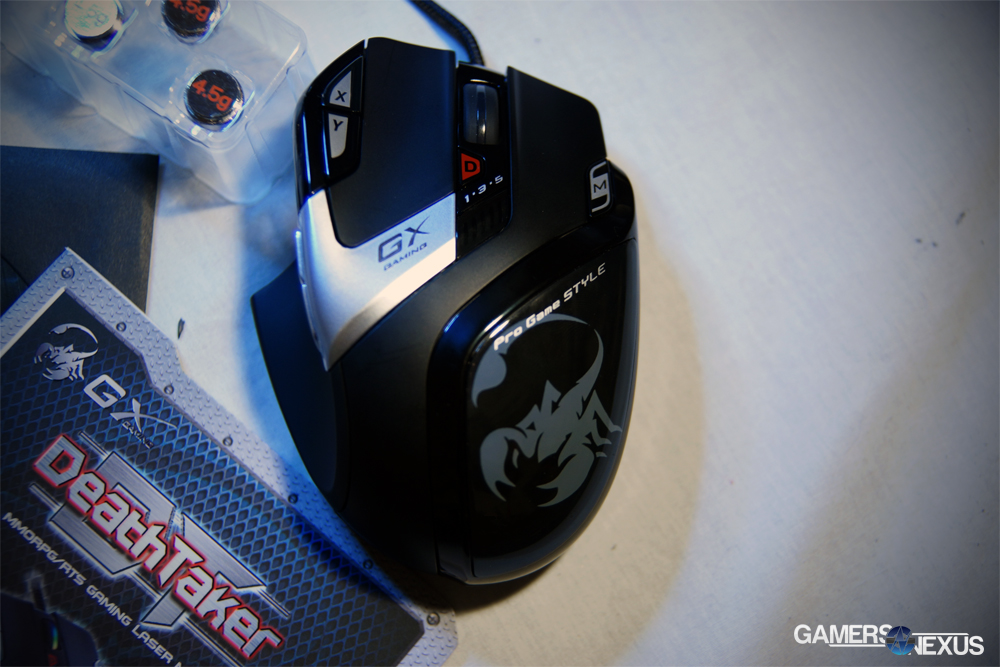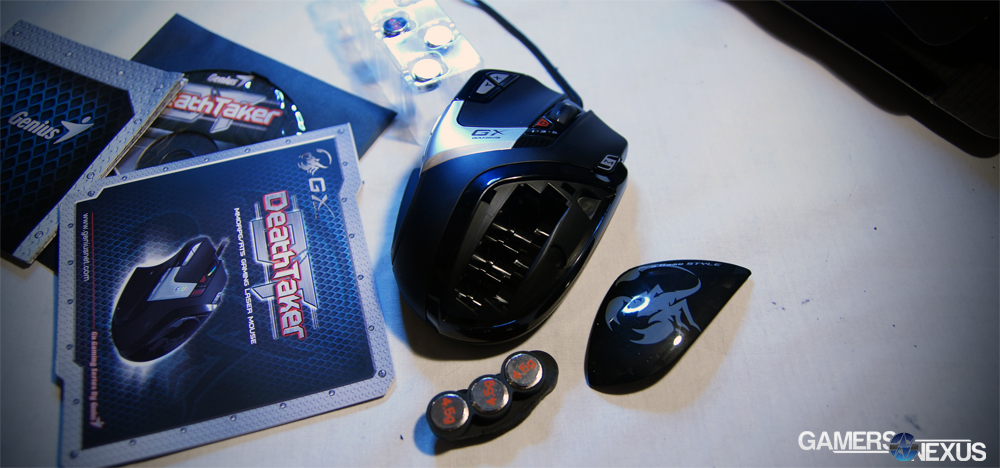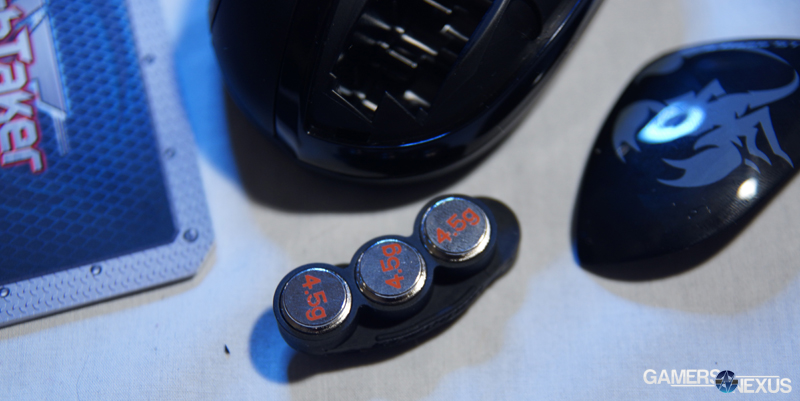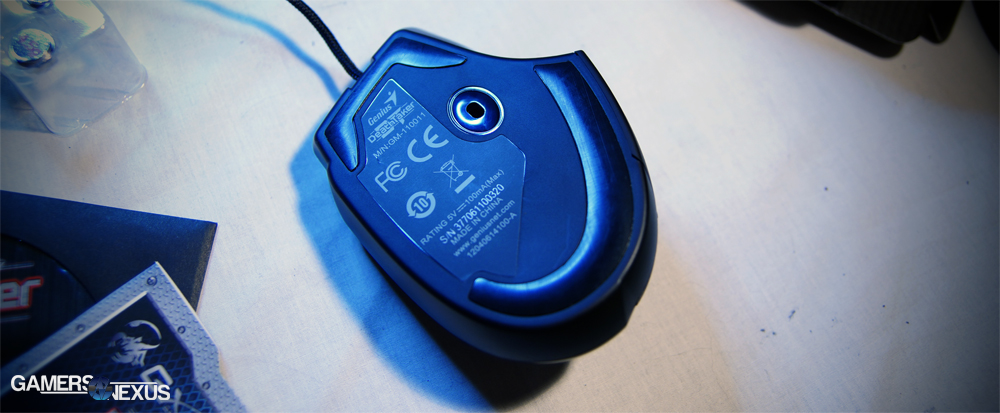We've been busy with PAX here at GamersNexus for the past weeks, but now the team is back and it's time to catch up on some peripheral reviews. First in line is a mouse—and it isn't Logitech this time (but you should also check out our Logitech roundup)—no, this time it's the Genius DeathTaker. Just let that name sink in for a moment.
Genius is the brand name of KYE Systems Corporation, a Taiwanese company with a focus on general computer peripherals; they make just about everything, ranging from drawing tablets, to mouse pads, to speakers, to mice, and they've recently begun exploring the PC gaming space with their new GX Gaming lineup. The DeathTaker is part of their GX Gaming devices (so is the Gila - be sure to keep an eye out for a review soon) and has been labeled as an "MMORPG/RTS Gaming Laser Mouse," although it's not tailored to those two genres exclusively, or at all: it's more of a jack of all trades.
This article aims to review Genius' DeathTaker MMO/RTS gaming mouse, talk about its pros/cons, execution, and overall performance in gaming.
Genius Deathtaker Gaming Mouse Specs & Features
In case you aren't willing to wade through the explosions on the GX Gaming page, here are the Genius DeathTaker specs:
- Resolution range from 100-5700 DPI
- 30G maximum acceleration
- 150 in. per second maximum speed
- 250-1000Hz polling rate
- 12000 FPS (frame rate)
- 1-5mm detection level
- 1.8m braided cord, gold-plated USB
- Avago ADNS-9500 Sensor
The style you see above is the only one offered, composed of mostly matte-black plastic with glossy black and silver sections. The mouse wheel and GX logo do light up in 16 million colors, though, with variable pulsing and intensity!
I chose blue. We'll talk about that more in a moment.
The DeathTaker has a fairly traditional button arrangement: two buttons under the thumb (mouse 4 / mouse 5 by default) are the main bindable keys, there's also a macro button (middle-finger position), X/Y DPI adjustment buttons (index position), a DPI switch button (centered), left/right click, and a middle-click on the mouse wheel, all of which can have their functions changed (except LMB).
The mouse uses switches supplied by T-MEC for the LMB/RMB button presses and is fueled by Avago's ADNS-9500 sensor, a company we spoke about recently in a post about how mice interact with mousing surfaces. The DeathTaker uses an integrated memory chip with storage capacity for up to 55 macros.
Simple LEDs are used for the backlighting and Polytetrafluoroethylene (teflon) feet are used for the underside of the mouse.
What's in the Box?
The best source of information about the mouse is on the actual package, which is a bit inconvenient for anyone who doesn't already own it. Included in the package is an instruction booklet in 10 languages informing the user about how to open the mouse and add or remove weights. There are 6x4.5 gram weights the size of chunky button batteries which can be inserted in various configurations into the palm of the mouse (the instructions are unnecessary; you could probably get a clever-ish monkey to do it). A CD includes the proprietary mapping software; GN's Steve put together a video overview of the software, found a little bit below.
That's really it. Unlike other mice, like the G600, the DeathTaker does not ship with teflon feet replacements.
Theoretical Application of Features
There are four buttons that aren't self-explanatory: Macro, DPI X and Y, and DPI switch. With the macro function, the user can execute a series of keystrokes with one press - I'll discuss that in the software section later on. When the user holds down the DPI X or DPI Y key while scrolling up or down, it adjusts the DPI for that axis only; this can be useful for cinematic screens (ultra-wide) to create a monitor-proportionate movement speed, and while it's mostly useless in gaming, we'd imagine artists would be most likely to reap benefits from the feature. Finally, the DPI switch is used to cycle between 5 DPI levels that are pre-designated by the user. There isn't a huge number of special functions, but they're useful ones, which is more important.
The six included weights are inserted side-by-side in pairs from the back of the mouse to the middle, meaning that it's possible to alter the distribution of mass to some minor degree. If you want to shift your center of mass more toward the front, perhaps for better pull/twitch-response, that's somewhat possible.
Genius Deathtaker Comfort and Ergonomics
It's certainly no Logitech G600, but the DeathTaker is reasonably comfortable. The short, wide shape encourages a claw grip, with the ring finger resting on a nubbin on the right side of the mouse. It isn't the most comfortable design for long sessions, but it does grant mobility for quick side-to-side swipes. I especially appreciated the wide scoop on the left side, providing both a place for the thumb to grasp the mouse and a place to rest the thumb without rubbing it on the mousepad, all without inhibiting access to the mouse 4 and mouse 5 buttons. I do, however, wish that these buttons were farther forward, as I have to bend my thumb awkwardly inward in order to reach them.
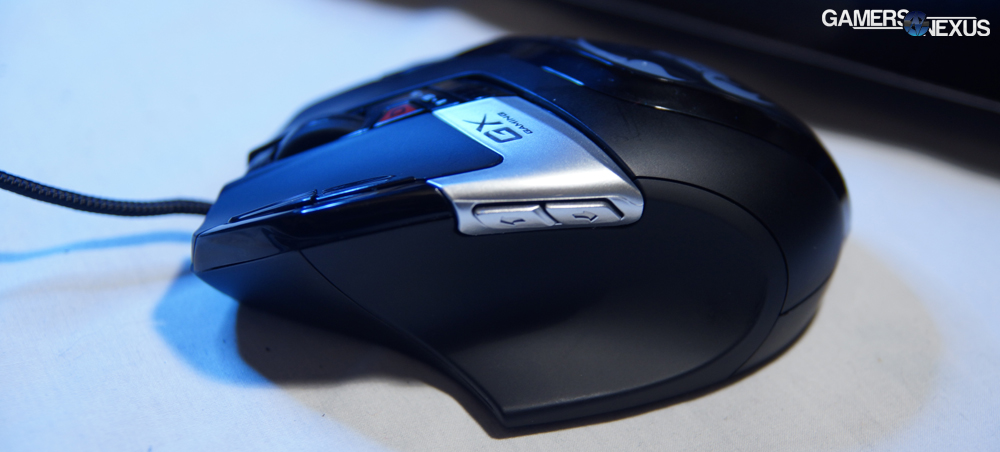
The outside of the mouse is composed of several panels of plastic of different materials, which has two potential downsides: First, glossy plastic is used for the palm rest/weight chamber lid, possibly leading to sweaty/sticking palms, and second, the cracks between buttons and panels are the perfect spot for grime to collect. The human hand is a nasty object.
Real-World Applications & Practicality
Adjustable weight is a great feature, or so GN's Steve tells me. I'll admit that I'm not enough of a pro to be picky about how much my mouse weighs, but I can dream--I chose to put all the weights in, both because the DeathTaker isn't an especially large mouse, and because otherwise I would lose them. Even I can notice a 27 gram difference, and if I can, anyone can. It's a feature worth having for picky gamers; though I personally don't notice a huge difference in 'performance.'
In everyday gaming, I found myself using mouse-5 (the more easily reachable of the two side buttons) and the DPI switch button. I recognize the purpose of the macro button, if not the X and Y DPI adjust buttons, but I simply have no use for it. If you do use macros, my advice would be to bind them to the X and Y buttons--they're far easier to see and press than the default macro button. The DPI switch button comes in handy for quickly switching to a higher or lower DPI, ideal for dropping into high-precision sniping, but you have to cycle through all 5 profiles to get back to the original one—one of the reasons why I liked the Logitech G600's DPI shift so much (it just jumps between two settings).
KYE Systems Corporation, Genius' parent company, made the very first mouse with a scroll wheel. Can you believe that? It's been quite some time. The DeathTaker is far ahead of that, though: it uses the Magic Roller, which was patented in the futuristic year of 1996. All joking aside, it's a good mouse wheel with a satisfying click and smooth ratcheting, although it lacks the side-to-side movement of Logitech's design.
Aesthetics are entirely a matter of opinion, so I'll make this short. The DeathTaker is very clearly made of plastic and lacks the presence of the current trend-like utilization of hydrophobic materials. It looks cluttered with logos and shiny bits everywhere, with the glossy surfacing feeling a bit less inviting than more grippier surfaces. That said, it matters more what's on the inside of the mouse, and neither the plastic shell nor the patchwork exterior actually affect the objective performance. They may affect the desirability of the mouse and your ability to play for long sessions, though, especially when taking the awkward ergonomics into account.
Software Included
Luckily, the DeathTaker configuration software keeps things simple. Genius takes the extra step of including a driver CD in the package, which I appreciate; every second not spent googling drivers is a second well spent.
On the bottom of the window, there are five tabs for the profiles stored on the mouse, a button for saving the current profile as an .ini file, and a button for loading a previously-saved profile. Simple enough. On the top of the window are four tabs: Assign buttons, manage macro, advanced setting[s], and light options. I'm sure you guys are clever enough to assign buttons and adjust the LED on your own; it's the macro and advanced settings tabs that are complicated.
Macro, in this case, means using one mouse key to execute a series of keystrokes (yes, I know I already said that, be quiet). I could try to describe in-text how to assign macro keys, or I could link you to Steve's aforementioned YouTube video instead:
The most important thing to remember is that after naming and creating a macro, you must assign it to a mouse button -- if the mouse button is bound to "Macro Button," it's still on the default setting, and won't do anything when pressed.
Advanced settings tab covers six different areas: mouse speed, scroll speed, double click speed, sensitivity, polling rate, and DPI. A few of these options are inherited from Windows, others are added.
As for mouse speed, keep it toward the mid-range and then adjust the DPI instead, and the "enhance pointer precision" checkbox is another name for the evil that is mouse acceleration. Scroll speed is pretty obvious, as well as double-click speed--the higher the number, the faster you have to double click. Mouse sensitivity might be useful if you want a high DPI without having your cursor zoom all over the place, but frankly, I don't have a problem with just adjusting DPI instead of sensitivity.
The polling rate can be set to either 250Hz, 500Hz, or 1KHz, which makes for a much easier decision than an adjustable slider. Having a polling frequency that's too high can bog down the CPU with constant interrupts from the mouse, but modern CPUs won't struggle with even the 1KHz response time; that said, we did have issues with mouse freezing and disconnects when at high frequencies, and were forced to drop down to 500Hz. This is theoretically a software issue and not a hardware issue, and Genius has swapped samples with us so they can debug the issue.
Most importantly, the DPI setting can be adjusted with a slider for the current profile or for all 5 profiles when the "stage" option is selected. From this menu, X and Y DPI values for each profile can be individually adjusted, if that's appealing to you.
Finally, there's a box that says "enable OSD" (on-screen display), effectively just a software interface/HUD for Windows that indicates your DPI switching actions. The pop-up has a tendency to minimize games and cause screen flickering in full-screen applications, so I kept this box unchecked; that's OK, though, because there's an LED on the mouse which clearly indicates the current profile.
Genius Deathtaker Value and Conclusion
You should be able to get the DeathTaker for about $50, a significant discount from the list price of $70 and, in my opinion, it's not an unreasonable amount. The DeathTaker is a versatile, mid-range mouse, with adjustable weight and one-click DPI adjustments.
It may not sound like it, but I actually prefer the DeathTaker over the more expensive G600 I reviewed earlier, precisely because of its versatility. Button-placement is more generally easier to memorize and map, for one, and the weight cartridges are a neat feature. I would have chosen a simpler design if possible and would prefer a shape that contours more naturally to my hand, but otherwise I'm a happy camper. My recommendation? If you're looking to spend around $50, buy it.
We will be reviewing Logitech's brand new G500s and G700s this week, so do consider holding out for those.
- Patrick Lathan.
